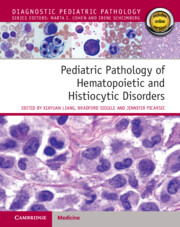Book contents
- Pediatric Pathology of Hematopoietic and Histiocytic Disorders
- Pediatric Pathology of Hematopoietic and Histiocytic Disorders
- Copyright page
- Epigraph
- Contents
- Contributors
- Section I General Hematology and Hematopathology
- Section II Non-Neoplastic Hematologic Disorders of Blood and Bone Marrow
- Section III Non-Neoplastic Disorders of Extramedullary Lymphoid Tissues
- Section IV Neoplastic Disorders of Bone Marrow
- Section V Mature Lymphoid Neoplasms
- Chapter 20 Mature B-Cell Non-Hodgkin Neoplasms
- Chapter 21 Mature T-Cell and NK-Cell Non-Hodgkin Lymphomas
- Chapter 22 Hodgkin Lymphoma
- Chapter 23 Immunodeficiency-Associated Lymphoproliferative Disorders
- Section VI Histiocytic Disorders and Neoplasms
- Index
- References
Chapter 21 - Mature T-Cell and NK-Cell Non-Hodgkin Lymphomas
from Section V - Mature Lymphoid Neoplasms
Published online by Cambridge University Press: 25 January 2024
- Pediatric Pathology of Hematopoietic and Histiocytic Disorders
- Pediatric Pathology of Hematopoietic and Histiocytic Disorders
- Copyright page
- Epigraph
- Contents
- Contributors
- Section I General Hematology and Hematopathology
- Section II Non-Neoplastic Hematologic Disorders of Blood and Bone Marrow
- Section III Non-Neoplastic Disorders of Extramedullary Lymphoid Tissues
- Section IV Neoplastic Disorders of Bone Marrow
- Section V Mature Lymphoid Neoplasms
- Chapter 20 Mature B-Cell Non-Hodgkin Neoplasms
- Chapter 21 Mature T-Cell and NK-Cell Non-Hodgkin Lymphomas
- Chapter 22 Hodgkin Lymphoma
- Chapter 23 Immunodeficiency-Associated Lymphoproliferative Disorders
- Section VI Histiocytic Disorders and Neoplasms
- Index
- References
Summary
Peripheral (mature) T-cell lymphomas (PTCLs) are much less common than B-cell lymphomas. Derived from post-thymic T-cells, PTCLs generally arise in lymphoid tissues “peripheral” to the thymus, such as the lymph nodes, spleen, gastrointestinal tract, and skin. Because natural killer (NK) cells and T-cells arise from a common progenitor cell and have some overlapping properties, NK-cell lymphomas are considered together with PTCLs in the World Health Organization (WHO) classification system [1].
PTCLs occur most frequently in adults and less frequently in children and adolescents. They comprise about 10–15% of all non-Hodgkin lymphomas (NHLs) in pediatric age groups [2]. NK-cell neoplasms are even rarer. Unlike adults, where there is a broad spectrum of T-cell neoplasms, the most common type of PTCL in pediatric patients is anaplastic lymphoma kinase (ALK)-positive anaplastic large cell lymphoma, with other subtypes of PTCL (0.9%) being observed much less frequently [3].
- Type
- Chapter
- Information
- Pediatric Pathology of Hematopoietic and Histiocytic Disorders , pp. 263 - 284Publisher: Cambridge University PressPrint publication year: 2024



